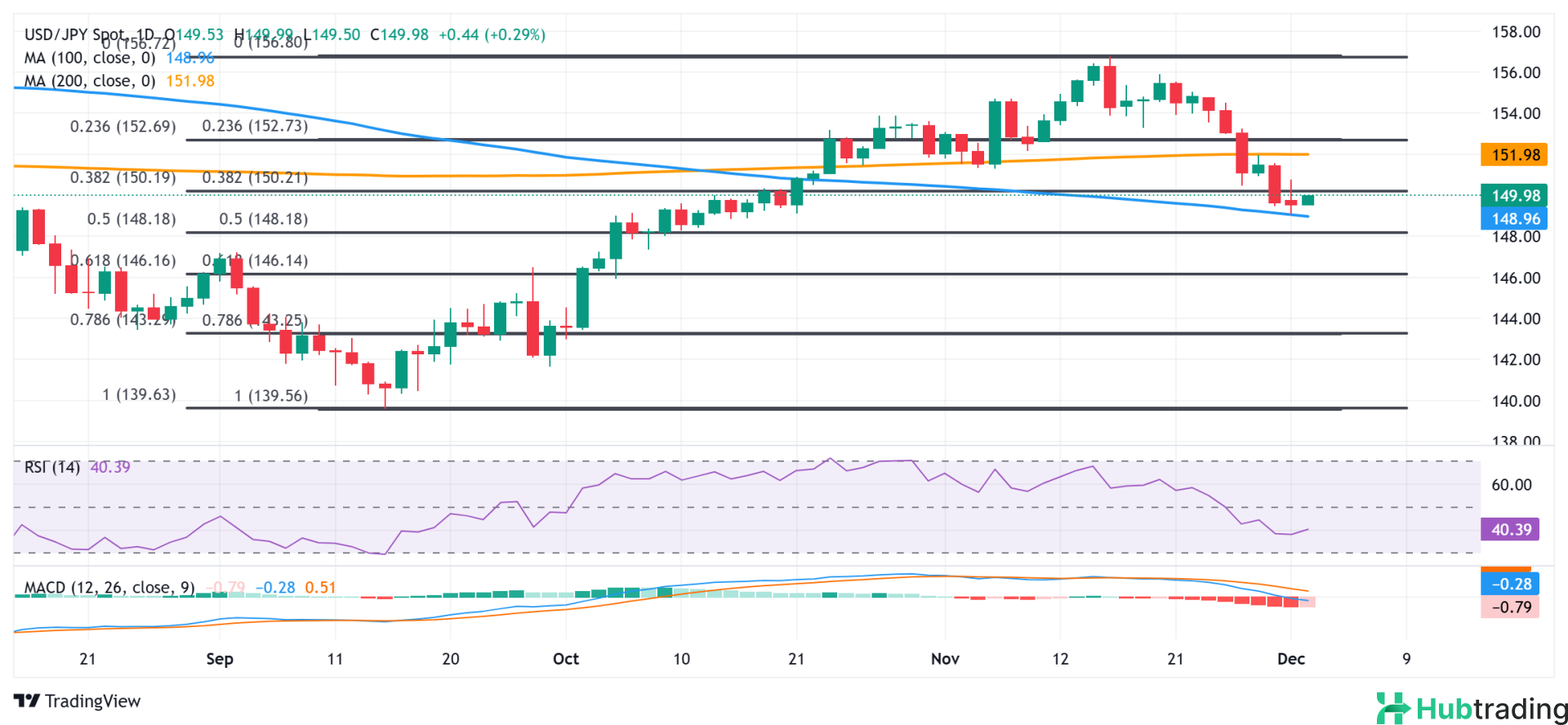- The Japanese Yen faces selling pressure on Tuesday, but losses remain capped.
- Growing expectations of another Bank of Japan (BoJ) rate hike in December provide support for the JPY.
- Geopolitical risks, Trump’s tariff threats, and subdued US bond yields bolster the case for JPY bulls.
The Japanese Yen (JPY) remains under pressure in early European trading on Tuesday, enabling the USD/JPY pair to hold modest gains near the psychological 150.00 level, supported by a slight uptick in US Dollar (USD) strength. However, the JPY’s downside appears limited amid speculation that the Bank of Japan (BoJ) could implement another interest rate hike in December. Additionally, concerns surrounding US President-elect Donald Trump’s tariff plans, persistent geopolitical risks, and declining US Treasury bond yields provide support for the lower-yielding JPY.
Meanwhile, the USD struggles to sustain its recovery from an almost three-week low, potentially capping further upside for the USD/JPY pair. Traders seem cautious, awaiting more clarity on the Federal Reserve’s (Fed) rate-cut trajectory before making fresh directional bets. Key US macroeconomic data, including Friday’s Nonfarm Payrolls (NFP) report, and Fed Chair Jerome Powell’s upcoming speech are expected to provide critical insights into the US interest rate outlook and drive market sentiment.
Japanese Yen Bears Remain Cautious Amid Hawkish BoJ Expectations, Trade War Concerns, and Geopolitical Risks
- The Tokyo November Consumer Price Index (CPI) indicated accelerating underlying inflation, fueling expectations of a potential rate hike by the Bank of Japan (BoJ) in December. BoJ Governor Kazuo Ueda reiterated on Saturday that the central bank would adjust its monetary easing measures if it becomes confident inflation is on track to reach the 2% target.
- Geopolitical tensions remain high as Russia launched at least 60 North Korean missiles against Ukraine. North Korean leader Kim Jong Un pledged unwavering support for Moscow, further escalating the situation.
- In the US, President-elect Donald Trump renewed trade war fears by pledging significant tariffs on major trading partners and BRICS nations. He also opposed Nippon Steel’s proposed $15 billion acquisition of US Steel, vowing to block the deal.
- Concerns are mounting that Trump’s tariff plans and expansionary policies could reignite inflationary pressures, potentially prompting the Federal Reserve to pause or reverse its rate-cutting trajectory.
- Meanwhile, the ISM Manufacturing PMI rose to 48.4 in November, reflecting optimism around business-friendly policies from the Trump administration. Despite this, CME Group’s FedWatch Tool shows a 75% probability of a 25-basis-point rate cut by the Federal Reserve later this month.
- The 10-year US Treasury yield has fallen to its lowest levels since late October, narrowing the US-Japan yield spread and supporting the lower-yielding Japanese Yen.
- Investors are now focused on key US economic data and Fed Chair Jerome Powell’s upcoming comments for further insights into the central bank’s rate path. These developments are likely to influence the USD and the USD/JPY pair in the coming sessions.
USD/JPY Struggles to Extend Gains Beyond 150.00; Limited Upside Potential

From a technical standpoint, last week’s drop below the 38.2% Fibonacci retracement level of the September-November rally serves as a fresh bearish signal. Oscillators on the daily chart remain deeply in negative territory and are far from oversold levels, indicating that the path of least resistance for the USD/JPY pair is to the downside. However, a modest bounce from the 100-day Simple Moving Average (SMA) support near 149.00 warrants caution before positioning for further declines. A decisive break below this level could lead to a slide toward the 50% retracement at around 148.20, with the 148.00 level acting as a key support. Continued selling pressure could test the 61.8% Fibonacci level around 147.00, with intermediate support near 147.35.
On the upside, further strength beyond the 150.00 psychological level faces significant resistance near the recent swing high at 150.75, followed by the 151.00 round figure. A sustained break above 151.00 could spark a short-covering rally, pushing the USD/JPY pair to 151.65 and potentially toward the 152.00 mark. The 200-day Simple Moving Average (SMA) at 152.00 represents a crucial resistance level. A decisive break above this could indicate that the recent corrective pullback has ended, shifting the near-term bias back toward bullish sentiment.





